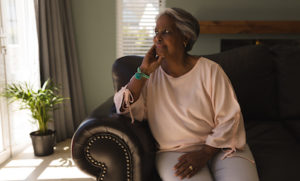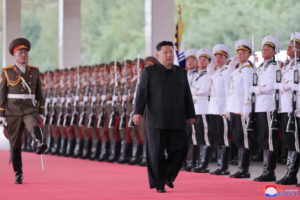What we do
Climate change and displacement
Refugees, internally displaced and stateless people are on the frontlines of the climate crisis. UNHCR is working to protect them and strengthen their resilience to its current and future impacts, while also reducing our own environmental footprint.
In this section:
Law and policy for protection and climate action
Strengthening climate adaptation and resilience
The climate crisis is amplifying displacement and making life harder for those already forced to flee.
Climate change and displacement are increasingly interconnected. As extreme weather events and environmental conditions worsen with global heating, they are contributing to multiple and overlapping crises, threatening human rights, increasing poverty and loss of livelihoods, straining peaceful relations between communities and, ultimately, creating conditions for further forced displacement.
The majority of people forcibly displaced by persecution, conflict and violence today live in countries that are highly vulnerable and ill-prepared to adapt to climate change.
Displaced populations frequently have no option but to live in remote locations, in overcrowded camps or informal settlements, with limited access to basic services or infrastructure and where they are highly exposed and vulnerable to climate hazards like floods, drought, storms and heatwaves. In addition, the climate crisis is disrupting livelihoods and making it more difficult for displaced people to become self-sufficient. Climate impacts can also escalate tensions and conflicts over vital resources like water, fuel and arable land, threatening peaceful coexistence between displaced populations and host communities.
Most refugees and internally displaced people also come from highly climate-vulnerable countries where weather shocks and worsening climatic conditions add to the challenges that make sustained peace and safe return difficult to achieve.
Without help to prepare for, withstand, and recover from climate-related shocks and stresses, they also face increased risks of becoming displaced again. Addressing climate change as a root cause of displacement is crucial to breaking this cycle and finding lasting solutions.
UNHCR’s response to the climate crisis
Building on UNHCR’s Strategic Framework for Climate Action our Strategic Plan for Climate Action 2024-2030 details a global roadmap for prioritized action in support of governments and in collaboration with a wide range of partners to realize the following ambitious goal:
That by 2030, increasing numbers of forcibly displaced and stateless people fleeing from climate-fueled crises and/or living in climate-vulnerable countries find solutions, are protected and resilient to the impacts of climate change, and have the means to live self-sufficient lives.
We cannot achieve this vision alone. In support of host governments, we will work with other humanitarian and development organizations, as well as the private sector to achieve four key objectives by 2030:
1. People fleeing persecution, violence and human rights violations occurring in relation to the adverse effects of climate change and disasters who need international protection are effectively protected.
- UNHCR is working to increase the understanding of international protection entitlements arising for people displaced in the context of climate change and disasters and to increase the technical capacity of state institutions and other partners to respond to asylum claims of people displaced in these contexts.
- UNHCR is assisting States to protect and support their citizens in situations of internal displacement and supporting the development of laws and policies relevant to internal displacement in the context of climate change.
2. Forcibly displaced and stateless people and their hosts can access services that promote the sustainable use of natural resources and a clean and healthy environment.
- UNHCR is engaging with displaced communities to preserve and rehabilitate the environment, transition to renewable energy and increase displaced people’s access to climate-smart water and sanitation services.
3. People forced to flee, stateless people and their hosts can prepare for, withstand, recover and be protected from the impacts of climate change.
- UNHCR is working with authorities and local responders to strengthen social protection services for displaced people affected by climate shocks and disasters. We also provide sustainable and climate-resilient shelter to shield displaced people from heavy rains and floods, as well as cash assistance.
- UNHCR is working with others to strengthen climate-resilient livelihoods, early warning systems and preparedness measures, and social protection programmes in displacement settings.
4. UNHCR minimizes its own negative impacts on the environment.
- UNHCR is minimizing our own negative impacts on the environment by reducing our greenhouse gas emissions, transitioning to renewable energy sources, and improving the sustainability of our supply chain.
Download the Strategic Plan for Climate Action 2024 – 2030
Learn more about UNHCR’s work on climate change
Global Refugee Forum pledge on climate action
Countries hosting refugees are providing a global social good, while the costs and responsibilities they shoulder grow heavier due to climate change. Urgent action is required to scale up accessible financing and support that will enable displaced and host communities to develop local solutions to the most pressing climate challenges they face.
At the second Global Refugee Forum, governments, NGOs and stakeholders joined together in a multistakeholder pledge. Through this, they committed to sharing best practices and combining resources in order to enhance access to climate action resources and funding for refugee and host communities.
Learn more: Global Refugee Forum 2023 multistakeholder pledge on climate action

© UNHCR/Usman Ghani
CASE STUDY
Pakistan floods
In 2022, Pakistan saw one third of its territory submerged by flooding, displacing 8 million people, including thousands of Afghan refugees.
Bahadur, a 60-year-old grandfather, was one of over 2,000 Afghan refugees living in Kheshgi Refugee Village in north-western Pakistan at the time of the floods. The flood waters broke through a nearby embankment in the early hours of the morning and he had only 10 minutes to evacuate his loved ones to higher ground before his home was swept away.
“Our house was inundated within minutes. We had no other option but to leave at once.”
Bahadur Khan, Afghan refugee
The Government of Pakistan initiated a response and appealed for international support. UNHCR responded by providing thousands of tents and other relief items such as plastic tarpaulins, sanitary products, cooking stoves, blankets, solar lamps, and sleeping mats to refugees and host communities.
Partnerships
UNHCR is a signatory, member and/or implementing partner of:
- Climate and Environment Charter for Humanitarian Organizations
- Agenda for the Protection of People Displaced Across Borders in the Context of Climate Change and Disasters, and the Platform on Disaster Displacement
- COP28 Declaration On Climate, Relief, Recovery And Peace
- UNFCCC Warsaw International Mechanism on Loss and Damage Task Force on Displacement
- Risk Informed Early Action Partnership (REAP)
- Centre of Excellence for Climate and Disaster Resilience
- UN Plan of Action on Disaster Risk Reduction for Resilience
Resources
UNFCCC-related resources
Research and studies
- Insights into climate risk analysis and costing: Geospatial remote sensing in 30 settlements
- Moving from reaction to action – Anticipating vulnerability hotspots in the Sahel
- Bridging the divide in approaches to conflict and disaster displacement: Norms, institutions and coordination in Afghanistan, Colombia, the Niger, the Philippines and Somalia
- Climate change, displacement and human rights
- Factsheet: Climate change, displacement and human rights
- Factsheet: Gender, displacement and climate change
- Factsheet: Statelessness and climate change
Resources from partner organizations
- UNDP Climate Dictionary: An everyday guide to climate change
- IDMC Global Report on Internal Displacement 2023
- WMO State of the Global Climate Report 2022
- DPPA Climate Security Mechanism Toolbox
- Extreme heat: Preparing for the heatwaves of the future
- FAO Rapid response and mitigation plan to avert a humanitarian catastrophe
- World Bank Middle East & North Africa Climate Roadmap (2021-2025)
- World Bank Group South Asia Climate Roadmap (2021-2025)
- Anticipation Hub
- Environment in Humanitarian Action (EHA) Connect, Crisis Response and Recovery




